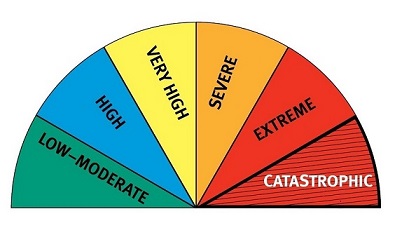
11 Nov Bushfire Exposure – Risk Management Insight
Every year Australia experiences a bushfire season during the summer period.
The weather conditions play an important part in determining the level of risk for property located within a bushfire prone area. If property is at risk, then potentially so are
people’s lives.
The word bushland doesn’t just mean trees and forest. It also means areas such as scrub, grassland, crops, woodland and farmland.
Bushfire prone areas are determined by local government with the assistance of the State’s Rural or Country Fire Service.
HAZARD
Almost 90% of properties destroyed in a bushfire are lost because of burning embers, commonly referred to as ember attack. This is when burning twigs and leaves carried by the wind land on or around buildings. Embers can travel many kilometres from the fire so even if your property is located a good distance from bushland you may be at risk.
Look for the places embers could start fires; on the roof, under floors and around windows and doors and take action to prevent them.
Understand your level of risk. Think about the area your property is situated.
You are at risk if your property is located near the following environments.
Bushland: Close to or surrounded by bush.
Bushfires can be hot, intense and throw burning embers towards your property.
Grasslands: Grass fires can start easily and spread quickly.
Coastal: Fires in coastal scrub can be hot and fast moving.
Rural: Farmland or neighbouring paddocks where fires can spread quickly over great distances.
On a Hill: Fires travel uphill faster. For every 10 degrees of slope, the fire can double in speed.
PREPARE your property
You need to make important decisions before the fire season starts. There are some simple measures you can do around your property to prepare it for a bushfire. You need to prepare well beforehand as leaving it to the last minute is too late.
A well-prepared property will increase the safety of fire fighters and is more likely to survive a bushfire even if you leave early.
Top 10 actions that can be implemented before and during the bushfire season:
- Trim overhanging trees and shrubs. This can stop the fire spreading to the property.
- Mow grass routinely and remove the cuttings. Always maintain a clear area around the property.
- Remove material around the property that can burn. (e.g. combustible waste, flammable liquids and gases).
- Clear and remove leaves from roof gutters. Burning embers can set the building on fire.
- Maintain fire breaks along paddock boundaries.
- Install hose reels that will reach the building perimeters.
- Maintain a reliable source of water.
- Place water pipes from dams underground and install pumps.
- Keep water tanks full and connect them to pumps and hoses.
- Ensure that a fire tanker can access the property.
.
ACT
Know your Bushfire Alert Levels. The higher the fire danger rating the more dangerous the conditions. Know the fire danger in the area and what it means.
- Low-Moderate
- High
- Very High
- Severe
- Extreme
- Catastrophic
The fire danger rating gives an indication of the consequences of a fire, if a fire were to start. The rating is based on predicted conditions such as temperature, humidity, wind and dryness of the landscape. It indicates how a bushfire may act, what impacts there might be on the community if a fire were to start and when to implement your Bushfire Survival Plan.
Severe, Extreme and Catastrophic Fire Danger Ratings mean a fire will be unpredictable, uncontrollable and very fast moving. This could mean there is little or no warning about the threat of a bushfire. Therefore, everyone concerned needs to make sure they are informed and be ready to put their plan into action.
When the rating is Catastrophic, leaving early is the safest option.
Visit your state’s rural fire service website to determine whether or not your property is in a bushfire prone area and the current Fire Danger Rating.
Important note – the information provided here is general advice only and has been prepared without taking in account your objectives, financial situation or needs. Watkins Insurance Brokers Pty Ltd (ABN 23 059 370 455, AFSL 244427).
Important disclaimer – Watkins Insurance Brokers Pty Ltd ABN 23 059 370 455, AFSL 244427.
This newsletter (V9433 15/07/19 B) is for information purposes only and is not legal advice. This article has been reproduced with the consent of AAI Limited trading as Vero insurance.
For more risk management insights, visit https://www.vero.com.au/articles/risk-management-insights.html

